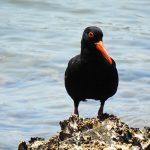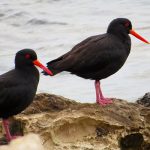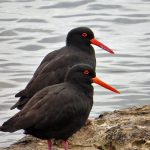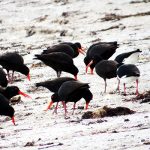SOOTY OYSTERCATCHER
The Sooty Oystercatcher (Haematopus fuliginosus)
The Sooty Oystercatcher is one of Australia’s most dramatic coastal birds, cloaked entirely in black with a glowing red bill and fiery eyes that seem to flash against the pale sand and grey rocks. It is a bird of rhythm and patience, tied to the rise and fall of the tides, and it carries with it fascinating behaviours and stories that reveal the beauty and fragility of Australia’s coastline.
A Story of the Shoreline
Imagine standing at dawn on a rocky headland. The sea has retreated, leaving glistening pools between the stones. The air smells of salt, and the hush of waves is broken only by a sharp piping call that carries across the breeze. Two dark shapes move with deliberate steps among the rocks—Sooty Oystercatchers.
Their long red bills probe into cracks, prising open mussels and limpets with practised precision. They work quickly, knowing the tide will return soon to cover their pantry. Side by side, they forage not as strangers but as lifelong partners, their bond as constant as the rhythm of the ocean.
What Makes the Sooty Oystercatcher Special
| Feature | Description |
|---|---|
| Appearance | Entirely black plumage, with a vivid red–orange bill and red eyes |
| Size | 42–52 cm in length; wingspan up to 80 cm |
| Diet | Shellfish, crabs, marine worms, and other small invertebrates |
| Habitat | Rocky headlands, sandy beaches, offshore islands |
| Lifespan | Up to 20 years |
| Behaviour | Monogamous pairs, fiercely territorial |
Interesting Facts
- Not Just Oyster Eaters: Despite their name, they eat a variety of coastal invertebrates, including mussels, limpets, crabs, and worms.
- Masters of Timing: They forage at low tide, carefully working the exposed rocks before the sea returns.
- Pairs for Life: Once bonded, they usually remain together, returning to the same nesting grounds year after year.
- Camouflaged Eggs: Their eggs are mottled to match sand and pebbles, making them nearly invisible.
- Protective Parents: Adults defend their chicks fiercely, sometimes pretending to be injured to lure predators away.
- Sedentary Specialists: Unlike many migratory shorebirds, they live year-round on Australia’s coastline.
- Conservation Concern: Vulnerable in New South Wales due to human disturbance, predators such as foxes, dogs and cats, and rising sea levels.
A Moment of Connection
Picture a nesting site on an isolated beach. The nest is nothing more than a shallow scrape in the sand, lined with fragments of shell. At its centre lie two speckled eggs, blending so perfectly that they seem part of the landscape itself. The parent birds remain nearby, watchful and alert. If a gull drifts too close, their sharp cries cut across the wind, and one bird rushes forward, wings outstretched, to drive the intruder away.
When the chicks hatch, tiny downy bundles emerge. For weeks they are vulnerable to predators and the sea itself, but under the care of their parents, they learn to feed, to move with the tide, and to survive on the shifting edge of land and ocean.
Why They Matter
The Sooty Oystercatcher is a sentinel of Australia’s shores. By feeding on shellfish and other invertebrates, it helps maintain balance in the intertidal zone. Its very presence is a reminder of the wildness of the coast and the importance of protecting places where tide, rock, and bird life weave together.
✨ In those quiet moments, when the tide has slipped away and the rocks gleam with seawater, the Sooty Oystercatcher stands like a spark of fire against the stone. To watch it is to glimpse the heartbeat of Australia’s coastline—a rhythm of survival, partnership, and resilience.




